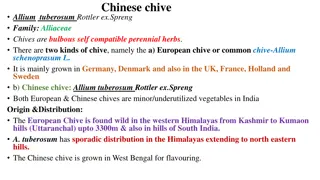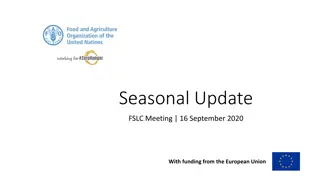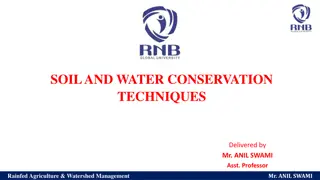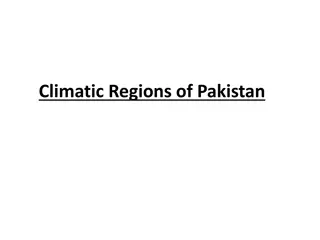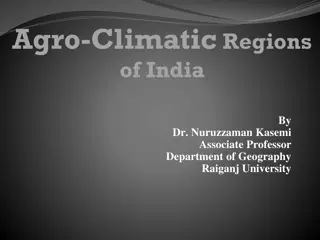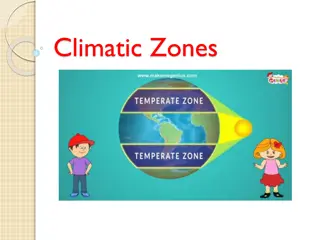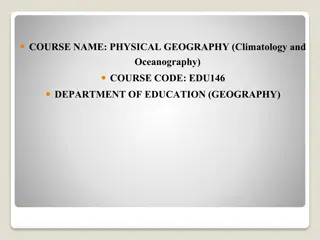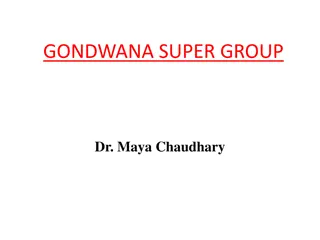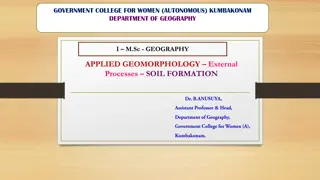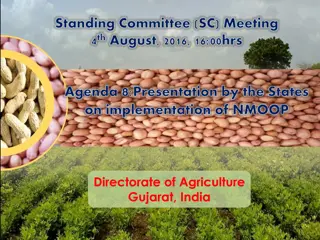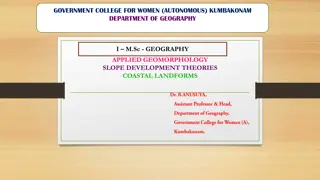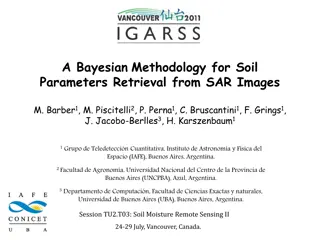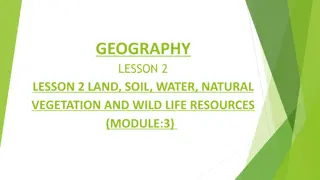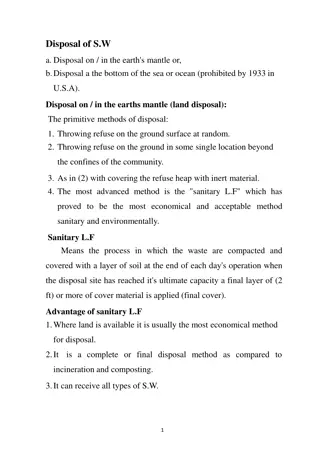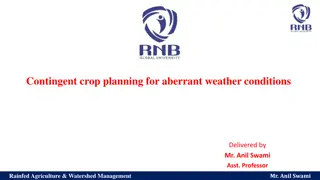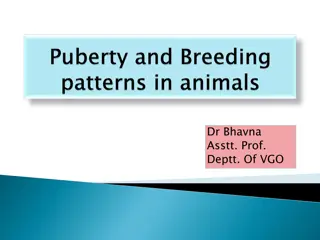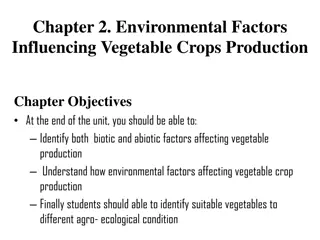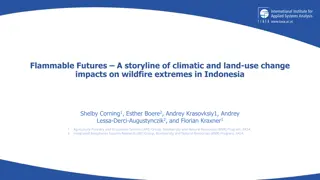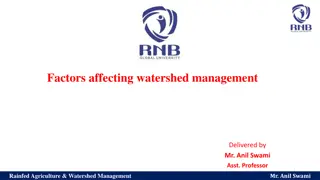PRODUCTION TECHNOLOGY OF BROADBEAN
Broad beans, scientifically known as Vicia faba L., are a valuable crop with significant nutritional value. This article covers the botanical description, nutritive value, cultivation practices, climatic requirements, and more for broad beans. Learn about the plant's growth habits, preferred soil co
2 views • 23 slides
Comprehensive Guide to Chinese Chive Cultivation and Uses
Chinese chive, a bulbous perennial herb, is cultivated in various regions including India. It is rich in nutrients, vitamins, and minerals, with mild garlic-like flavor useful in salads, garnishes, and traditional medicines. This guide covers its botany, cultivation practices, uses, and soil/climati
1 views • 7 slides
Seasonal Update and Forecast: Weather Trends and Recommendations for September 2020
Seasonal update highlights wettest months with flooding, GHACOF forecast for drier conditions, and current rainfall patterns. Key risks include continued flooding effects with recommendations for humanitarian support and livestock health services. FAO's flood impact analysis and FSNMS survey to prov
0 views • 8 slides
Soil and Water Conservation Techniques in Rainfed Agriculture by Mr. Anil Swami
Explore soil erosion and various conservation techniques discussed by Mr. Anil Swami, an Assistant Professor specializing in Rainfed Agriculture and Watershed Management. Learn about prevalent soil and climatic conditions in rainfed areas, water harvesting techniques, contingent crop planning, seaso
0 views • 66 slides
Understanding Atmosphere Composition and Structure in Climatology
The study of climatology, focusing on the atmosphere, is presented by Dr. Banashree Saikia, covering topics such as atmospheric composition, insolation, temperature variations, atmospheric pressure, wind systems, atmospheric moisture, climatic classification, cyclones, and monsoons. The atmosphere,
1 views • 9 slides
Climate and Climatic Regions of Pakistan
Pakistan exhibits diverse climatic regions ranging from sub-tropical continental mountains to arid desert plateaus. Factors like altitude, latitude, and distance from the sea greatly influence the country's climate. The country experiences weather conditions such as temperature variations, rainfall
0 views • 14 slides
Agro-Climatic Regions of India: Overview and Objectives
Explore the delineation and characteristics of agro-climatic regions in India, based on geo-climatic and socio-economic variations. Learn about the objectives focusing on agricultural production, farm income, rural employment, and regional development.
0 views • 27 slides
Natural Vegetation and Wildlife Sanctuaries in India
The natural vegetation in India varies based on climatic and topographical factors, leading to diverse flora such as Evergreen Rain Forests, Monsoon Deciduous Forests, and Desert ecosystems. The Himalayas showcase vegetation changes with altitude, while factors like soil and topography influence veg
2 views • 39 slides
Packaging of Eggs: Types, Factors, and Methods
Egg packaging is crucial to prevent shell damage and ensure product quality during storage and transportation. Factors affecting packaging include quality maintenance, storage facilities, transport type, distance traveled, climatic conditions, and costs. Various methods, such as using filler trays a
2 views • 10 slides
Exploring Earth's Climatic Zones
The Earth is divided into three climatic zones - Tropical Zone, Temperate Zone, and Polar Zone. The Tropical Zone is home to many countries and features diverse climates, including deserts. Nomads in this zone lead a mobile lifestyle, living in tents or huts and wearing protective clothing. Moving t
0 views • 36 slides
Understanding Atmospheric Moisture in Physical Geography
Atmospheric moisture, in the form of water vapor, liquid water, and ice, plays a crucial role in shaping weather and climate. This course delves into the dynamics of atmospheric moisture, including its distribution, effects on weather patterns, and impact on various climatic factors such as precipit
0 views • 7 slides
Understanding the Gondwana Super Group and Its Classification
The Gondwana Super Group, named after the Gond Kingdom, consists of sedimentary rocks deposited from the Carboniferous to Jurassic periods. These rocks provide insights into changing climatic conditions over millions of years. Classification of the Gondwana rocks is based on paleontological and lith
0 views • 23 slides
Understanding Soil Formation: Factors and Processes Explained
Soil formation is a complex process influenced by factors like parent material, topography, climate, organisms, and time. This article delves into the fundamentals of soil evolution, discussing how soils are formed from weathered rock materials and the role of pedogenesis. Factors affecting soil for
1 views • 28 slides
Major Formation Types of the World by Dr. Zaryab Khalid - BS Botany Semester 7
This presentation by Dr. Zaryab Khalid explores the major formation types of the world in the field of community ecology. It delves into the classification of natural and cultural vegetations, the concept of formation classes and subclasses, and details the six natural formation classes along with e
2 views • 7 slides
Understanding the Kӧppen Climate Classification System
The Kӧppen climate classification system, developed by Wladimir Kӧppen in 1884 and modified over the years, categorizes climates based on native vegetation as the best indicator. It recognizes five major climatic types designated by capital letters, reflecting temperature and precipitation pattern
0 views • 10 slides
Comprehensive Overview of Mustard Plant Cultivation
Mustard, scientifically known as Brassica indica, is a cool-season crop with origins in Europe. India leads in mustard production, with over 150 species primarily found in temperate regions. This versatile plant thrives in different soils and climatic conditions, offering a wide range of cultivation
0 views • 16 slides
Factors Influencing Plant Location Selection
Plant location selection is crucial for businesses, considering factors like proximity to raw materials, transport facilities, market accessibility, labor availability, and more. An ideal location minimizes costs, maximizes market share, and ensures social gains. Other factors include climatic condi
0 views • 24 slides
Understanding Plant Stress and Management of Excessive Moisture
Environmental stress, both biotic and abiotic, can negatively impact plant growth. Factors like temperature, water, radiation, chemicals, pollution, and more can lead to strain in plants, affecting their development. Excessive moisture, particularly waterlogging, is a significant stressor that can r
0 views • 35 slides
Agricultural Progress in Gujarat: Meeting Highlights and Crop Statistics
The Standing Committee meeting in Gujarat discussed the implementation of NMOOP in agriculture. Key points included land utilization details, agro-climatic zones, rainfall status, oilseed area percentages, and groundnut production scenarios. The presentation showcased data on crop areas and producti
1 views • 14 slides
Understanding Coastal Landforms: Formation and Characteristics
Coastal landforms are features shaped by erosion and sedimentation processes along coastlines. These landforms, including headlands, cliffs, bays, spits, salt marshes, and beaches, are predominantly influenced by factors such as wave action, longshore currents, tides, and climatic elements like wind
0 views • 35 slides
Bayesian Methodology for Soil Parameters Retrieval from SAR Images
Surface soil moisture retrieval is crucial for various applications such as climatic modeling, hydrological studies, and agronomy. This work focuses on developing a soil moisture retrieval algorithm using the SAOCOM L-Band polarimetric SAR system in Argentina. Limiting factors include spatial variab
1 views • 16 slides
Baikal Selenga Network (BaSeNet) - Hydrologic Research Program in PEEX
Baikal Selenga Network (BaSeNet) is a subprogram under PEEX focusing on studying waterborne matter transport in the Lake Baikal and Selenga River Drainage Basin. The program aims to quantify hydro-climatic impacts on large scales, utilizing a monitoring and modeling platform. Research objectives inc
0 views • 5 slides
Understanding Natural Vegetation and Wildlife Resources
Natural vegetation and wildlife play a crucial role in the biosphere, providing essential resources and maintaining ecological balance. The interaction between the lithosphere, hydrosphere, and atmosphere creates the biosphere where living organisms thrive. Plants offer timber, oxygen, and other val
0 views • 16 slides
Efficient Methods and Considerations for Solid Waste Disposal
Efficient methods for solid waste disposal include sanitary landfilling, which involves compacting waste and covering it with soil daily. Advantages of this method include economic viability and flexibility in waste disposal. However, challenges such as limited suitable land availability and potenti
0 views • 10 slides
Coastal Vulnerability Audit Tool (CVAT) for Curacao, Netherlands Antilles
This document outlines the stages of the Coastal Vulnerability Audit Tool (CVAT) for assessing the physical system and human system & engineering infrastructure of Curacao, Netherlands Antilles. It covers key aspects such as coastal setting, climatic and tectonic settings, topographic profile, coast
0 views • 10 slides
Coastal Vulnerability Assessment of Curacao, Netherlands Antilles
Conduct a comprehensive Coastal Vulnerability Audit of Curacao, Netherlands Antilles, using the Coastal Vulnerability Audit Tool (CVAT) to assess physical, human, and engineering infrastructure systems, as well as vulnerability, planning, and resiliency action plans. Consider factors such as climati
0 views • 10 slides
Post Harvest Methods in Cucurbits - Importance and Techniques
Different types of fruits and vegetables are grown in India due to varied agro-climatic conditions. India, being the second largest producer globally, faces significant post-harvest losses. Improper management practices such as careless harvesting, inadequate storage facilities, and processing metho
0 views • 39 slides
Wind as a Geologic Agent in Shaping Landscapes
Wind has played a significant role in shaping landscapes during times of drier climates, being a key geologic agent impacting erosion and deposition processes. The global wind system, driven by factors such as heating from the sun and the rotation of the Earth, creates convection currents that circu
0 views • 31 slides
The Fascinating Theory of Continental Drift Explored
In the early 1900s, Alfred Wegener introduced the groundbreaking hypothesis of continental drift, suggesting that the continents were once part of a single landmass before drifting apart to their current locations. This theory is supported by evidence such as the alignment of continents, shared foss
0 views • 25 slides
Strategies for Crop Planning in Aberrant Weather Conditions
Delve into the challenges of aberrant weather in rainfed areas, exploring soil and climatic conditions, water harvesting techniques, and contingency crop planning. Discover the impact of erratic rainfall patterns on crop growth and learn about midseason corrections to mitigate adverse effects. Explo
0 views • 24 slides
Sustainable Cultivation Strategies for EU Crops
This project, funded by the Horizon 2020 Programme, aims to develop sustainable cultivation strategies for various crops in the European Union. Tasks include geographic allocation, trials, sowing strategies, irrigation/fertilisation trials, crop rotation, field tests, and scenarios for raw materials
0 views • 24 slides
Factors Affecting Puberty and Reproduction in Animals
An animal reaches puberty when it can release gametes and exhibit complete sexual behavior. Puberty age varies across species, influenced by factors like breed, climate, nutrition, and management. Smaller species generally reach puberty earlier than larger ones. Climatic conditions and genetics also
0 views • 28 slides
Understanding the Importance and Cultivation of Maize Worldwide
Maize, known as the "Queen of the Cereals," is a versatile crop with diverse uses ranging from food to industrial products. Originating in South America, maize is now grown globally, including in India, where it plays a significant role in agriculture. This article explores the botanical details, di
0 views • 10 slides
Environmental Factors Influencing Vegetable Crops Production
Understanding the impact of environmental factors on vegetable production is crucial for maximizing yield and quality. This chapter focuses on identifying both biotic and abiotic factors affecting vegetables, the significance of agro-ecological conditions, and the role of climatic elements in vegeta
0 views • 87 slides
Ecological Factors and Climatic Influences on Plant Life
Ecological factors play a crucial role in shaping the environment for organisms to thrive. This includes living (biotic) and non-living (abiotic) components like climatic factors, edaphic factors, topographic factors, and biotic factors. Climatic factors such as light, temperature, water, wind, and
0 views • 14 slides
Impacts of Climate Change on Wildfire Extremes in Indonesia
A study explores the impacts of climatic and land-use changes on wildfire extremes in Indonesia, focusing on current and future climate-driven fires. The research examines the influence of factors such as drought, economic policies, and adaptation efforts on burned areas, agricultural losses, and la
0 views • 9 slides
Factors Influencing Watershed Management Explained by Mr. Anil Swami
Mr. Anil Swami, an Assistant Professor specializing in Rainfed Agriculture & Watershed Management, discusses the factors affecting watershed management. These factors are categorized into watershed characteristics, climatic characteristics, land use patterns, social status, and organization. Watersh
0 views • 18 slides
Understanding Factors and Prime Factors in Mathematics
Explore the concept of factors and prime factors through practical scenarios involving Jedward, stationary supplies, and school choirs. Learn how to find factors of numbers like 18 and 30, identify prime numbers, write numbers as products of prime factors, determine common factors, and calculate low
0 views • 19 slides
Factors Influencing COVID-19 Magnitude in Developing Countries: African Specificity
An exploration of factors influencing the magnitude of COVID-19 in developing countries, with a focus on any African specificity. The study uses diverse data from various developing countries to investigate the impact of demographic, economic, social service access, environmental, climatic, and heal
0 views • 16 slides
Understanding Latitude, Longitude, and Elevation for Weather Prediction
Latitude and longitude are used to locate places on Earth, while elevation represents the height above sea level. These geographical factors play a crucial role in determining temperature variations across different regions. The Equator, Prime Meridian, and other key lines help in dividing the Earth
0 views • 10 slides

